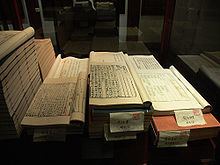Traditional Chinese 漢書 Hanyu Pinyin Wade–Giles Han shu | Simplified Chinese 汉书 Gwoyeu Romatzyh Hann shu IPA [xân ʂú] Date written 82 AD | |
 | ||
Preceded by Records of the Grand Historian Twenty-Four Histories books Records of the Grand Historian, Records of the Three Kingdoms | ||
The Book of Han or History of the Former Han is a history of China finished in 111, covering the Western, or Former Han dynasty from the first emperor in 206 BCE to the fall of Wang Mang in 23 CE. It is also called the Book of Former Han.
Contents
The work was composed by Ban Gu, a court official, with the help of his sister Ban Zhao, continuing the work of their father, Ban Biao. They modeled their work on the Records of the Grand Historian, a universal history, but theirs was the first in this annals-biography form to cover a single dynasty. It is the best source, sometimes the only one, for many topics in this period. A second work, the Book of the Later Han covers the Eastern Han period from 25 to 220, and was composed in the fifth century by Fan Ye (398–445).
Contents
This history developed from a continuation of Sima Qian's Records of the Grand Historian, initiated by Ban Gu's father, Ban Biao, at the beginning of the Later Han Dynasty. This work is usually referred to as Later Traditions (後傳), which clearly indicates that the elder Ban's work was meant to be a continuation. (It should be noted that other scholars of the time, including Liu Xin and Yang Xiong also worked on continuations of Sima's history.) After Ban Biao's death, his eldest son Ban Gu was dissatisfied with what his father had completed, and he began a new history that started with the beginning of the Han dynasty. This distinguished it from Sima Qian's history, which had begun with China's earliest legendary rulers. In this way, Ban Gu initiated the Jizhuanti (纪传体) format for dynastic histories that was to remain the model for the official histories until modern times.
For the periods where they overlapped, Ban Gu adopted nearly verbatim much of Sima Qian's material, though in some cases he also expanded it. He also incorporated at least some of what his father had written, though it is difficult to know how much. The completed work ran to a total of 100 fascicles 卷, and included essays on law, science, geography, and literature. Ban Gu's younger sister Ban Zhao finished writing the book in 111, 19 years after Ban Gu had died in prison. An outstanding scholar in her own right, she is thought to have written volumes 13–20 (eight chronological tables) and 26 (treatise on astronomy), the latter with the help of Ma Xu. As with the Records of the Grand Historian, Zhang Qian, a notable Chinese general who travelled to the west, was a key source for the cultural and socio-economic data on the Western Regions contained in the 96th fascicle. The "Annals" section and the three chapters covering the reign of Wang Mang were translated into English by Homer H. Dubs. Other chapters have been rendered into English by A.F.P. Hulsewé, Clyde B. Sargent, Nancy Lee Swann, and Burton Watson.
Ban Gu's history set the standard for the writings of later Chinese dynasties, and today it is a reference used to study the Han period. It is regarded as one of the "Four Histories" 四史 of the Twenty-Four Histories canon, together with the Records of the Grand Historian, Records of the Three Kingdoms and History of the Later Han.
Annals
Ji (紀, annal), 12 volumes. Emperors' biographies in strict annal form, which offer a chronological overview of the most important occurrences, as seen from the imperial court.
Chronological tables
Biao (表, tables), 8 volumes. Chronological tables of important people.
Treatises
Zhi (志, memoirs), 10 volumes. Each treatise describes an area of effort of the state.
Biographies
Zhuan (傳, exemplary traditions, usually translated as biographies), 70 volumes. Biographies of important people. The biographies confine themselves to the description of events that clearly show the exemplary character of the person. Two or more people are treated in one main article, as they belong to the same class of people. The last articles describe the relations between China and the various peoples beyond the frontiers.
Mentioning of Japan
The people of Japan make their first unambiguous appearance in written history in this book (Book of Han, Volume 28, Treatise on Geography), in which it is recorded, "The people of Wo are located across the ocean from Lelang Commandery, are divided into more than one hundred tribes, and come to offer tribute from time to time." It is later recorded that in 57, the southern Wa kingdom of Na sent an emissary named Taifu to pay tribute to Emperor Guangwu and received a golden seal. The seal itself was discovered in northern Kyūshū in the 18th century. According to the Book of Wei, the most powerful kingdom on the archipelago in the third century was called Yamatai and was ruled by the legendary Queen Himiko.
